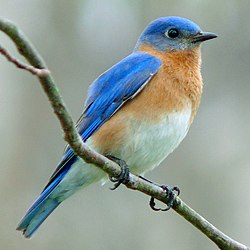 July 21st
July 21st
Written en route from San Francisco to Charlotte over the eastern end of the Nevada and Colorado deserts. We're in cloud; either we're flying low or this cloud is very high, probably the latter. It has been a noteworthy flight so far, with views of the long bridges over San Francisco Bay, of Oakland airport, the coastal ridges with their pale grassland, and the flat
San Joaquin Valley, then the Sierra Nevada, beyond which are desert sands and rocks with occasional salt pans. At times, no roads are visible. Now we're emerging from the desert area, over
Utah or Colorado, I think; I could see what looked like the
Colorado River just then, flowing south and cutting deep canyons in the landscape.
During the last two days, we've been travelling around on the ground, in a car rented in
San Pablo. Chris had finished work (talking about software for medical robots) on Wednesday, so successfully that his presence will be required in California again before the summer's out. In order to relax we drove across the
Richmond Bridge to the
Sausalito side of the Bay, twice making the mistake of joining the freeway in the wrong direction. so that we had to backtrack and try again. Not so relaxing after all, with the big trucks to contend with. Once off the busiest roads, heading in a more appropriate direction towards the Mt. Tamalpais State Park on Highway 1, we found a narrow road with with precipitous bends leading to Muir Woods. Chris didn't mind this kind of driving but it made me nervous, especially as some sections of the road had collapsed, reducing it to a single lane for traffic in both directions.
 Muir Woods
Muir Woods, justifiably well advertised as a place of wonder, had plenty of visitors, but parts of the trail system were quiet. The giant redwood trees there (
Sequoia sempervirens) grow more than 100m tall. Birds were calling, but we didn't spot any animals other than dragonflies until reaching the café at the end of the trail where a chipmunk took an interest in our sandwiches. A stream that runs through the steep, mossy forest hardly seems to supply enough water for all that vegetation; in fact much of the moisture comes from that misty cloud we kept seeing, that's formed by damp air rising up the hillsides near the ocean. The phenomenon is known as
fog drip. Tourists were taking photo after photo of the trees, especially in Cathedral Grove, awed by the size and age of them, but it's impossible to get adequate pictures.
 |
| Highway 1, between Muir Beach and Stinson Beach |
On to Muir Beach, a rocky, sandy cove at the mouth of a creek supposedly inhabited by sea otters and bobcats––no sign of them; we'd have to come back at a quieter time of day. I found small jellyfish on the shore and a few people were in the cold water trying to surf on the turning tide. An opportunity for me to go barefoot, lovely. Driving over the cliffs from there, we dropped down towards a longer beach, Stinson Beach, more populated. We only stopped for ices before wandering on past Bolinas Lagoon and along Francis Drake Boulevard (another windy road with pitfalls) over the watershed in the Samuel P. Taylor State Park, through attractive scenery, a mixture of forest and grassy rolling hills which appealed to me very much, although I'm sure there are snakes in that grass. And so down the valley to
Fairfax where people shop for organic veg., organic coffee, hempen clothing and magic cures for their ailments––you can picture it, I'm sure, a pretty little suburb of San Anselmo. No bookshops, however, and the same applied to
Napa in the vineyard country where we stopped the following afternoon.
 |
| A blur of vineyards, on the way to Napa |
 |
| Painted on a wall on First Street, Napa: famous inhabitants |
To reach these places, unless you're an extreme sort of cyclist, it's obligatory to use a car and pay the tolls to cross the impressive bridges over the estuaries in the Bay. We risked a detour up the Napa Valley on Friday afternoon to see the famous vineyards and the rocky, Provence-like hills above them, but nearly didn't get our rental car back in time because of the slow-moving traffic on Highway 29 ... luckily we picked up speed on the I-80, the main road from Sacramento.
 |
| Wikipedia picture of a bluebird |
I also took Chris for walks through the eucalyptus trees on
Point Pinole on both the Thursday and the Friday. To my delight we saw herons (grey and white), low-flying hawks, jays, junkos, a hummingbird, goldfinches and bluebirds (the first time I've ever seen those) and we picked ripe blackberries by the shore.
We never made it to the Golden Gate Bridge ferry ride we'd planned for Friday, due to trouble with our on-line bookings and the printing of our boarding passes for this flight. The hotel's computer, running a Microsoft OS, kept breaking down and held us up too long to catch the boat. Never mind. It was a satisfying trip, even so.
 Talking of music, I've had an email from the Music and Beyond team boasting of the success of this year's festival in Ottawa:
Talking of music, I've had an email from the Music and Beyond team boasting of the success of this year's festival in Ottawa:




















